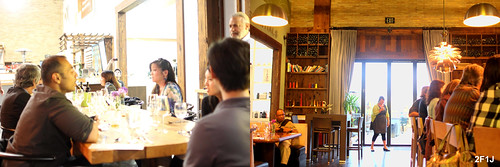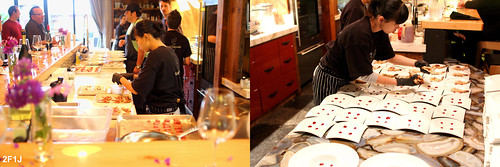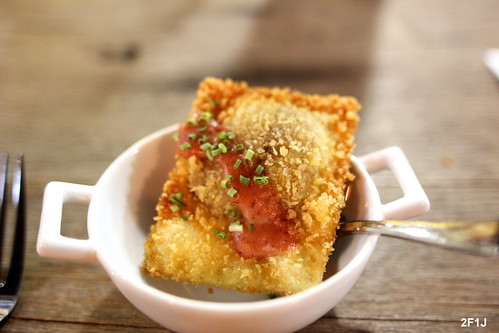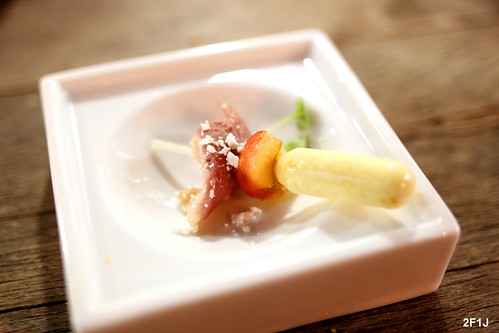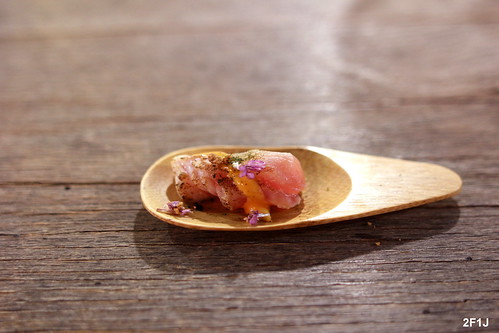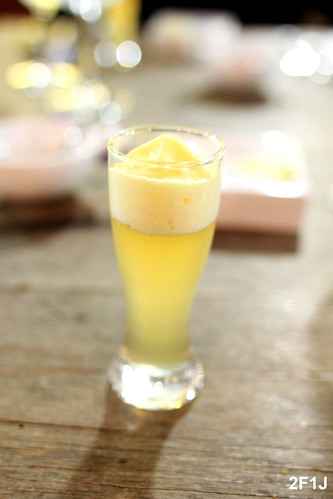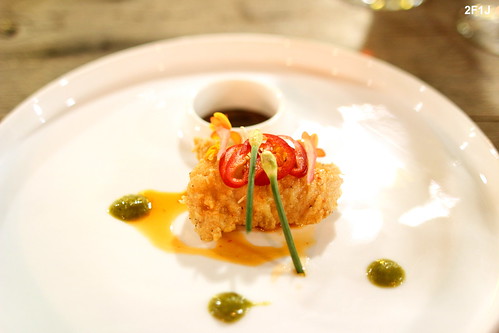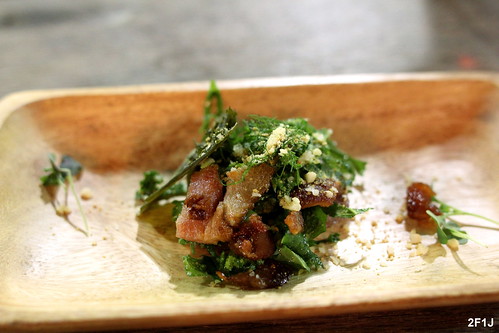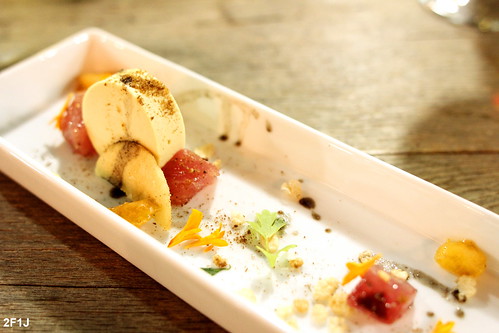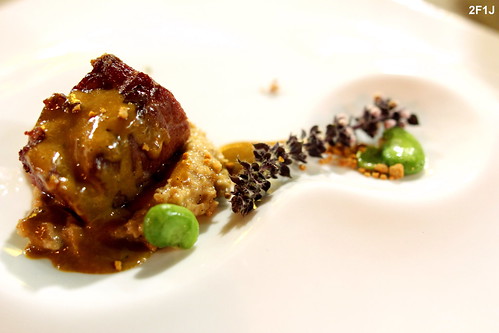Trends in
the food world are no different than trends in other parts of life. Some of
them evolve over time and become part of the mainstream food world like
“farm-to-table”. Today hardly any restaurant doesn’t use some kind of play on
the theme of farm-to table to describe their approach towards ingredients and
dishes. And even though the concept gets overused by now it also describes a
pleasant development of a stronger consciousness of restaurants and customers
alike towards a more thoughtful approach regarding sourcing of ingredients.
Some other trends get so overhyped that they become more of a stigma than
description so that they slowly fade away and only might reappear under a
completely different premise as it happened with molecular gastronomy. One of
the big buzzwords of the restaurant world in the 90s with pioneers like Ferran
Adria, it became more and more a cuss word for restaurants who didn’t
understand the original intend but forgot that the quality of the final dish is
key to a successful restaurant not the abundant use of new fancy techniques. Over
time many of the techniques and tools used during the molecular gastronomy
heydays became standard tools of many advanced kitchens like, sous-vide, vacuum
sealer, different stabilizers and enzymes and are used today without much
reluctance. Chefs using these modern tools understand by now that these are
just tools to achieve a better dish and not their main focus. This new attitude
was also captured by the seminal work of Nathan Myhrvold
and his team who wrote the book which labeled this field – Modernist Cuisine.
We
have seen quite a few restaurants in San Diego using tools from the modernist
cuisine arsenal and incorporating it in very impressive ways, like at Blanca,
Georges and Kitchen 1540 by using for example sous-vide, liquid nitrogen or
transglutaminase to name a few. But at the same time none of these restaurants
strongly advertised their use of these tools as they were just aids to achieve
their final dishes. And so it was just a matter of time until the first chef in
San Diego would use a more “direct” way to clearly advertise his work as part
of the Modernist Cuisine movement – Evolve Cuisine.
Evolve
Cuisine is the brainchild of Chef Daniel Barron. We first heard about Chef
Barron when we read about his work at Anqi in Costa Mesa which is an Asian
Fusion restaurant that also offered special molecular gastronomy tasting menus
at their chefs table. He got his start into the culinary world through the American Culinary Federation Apprenticeship Program at
the Townsend Hotel in Birmingham, Michigan before he worked successfulyl in a number
of restaurants in Nashville (Mad Platter), New York (Cesca) and Atlantic City (Donald
Trump’s Premier Casino Restaurant). More recently he moved to San Diego to take
a position as Executive Chef at Blue Point Costal Cuisine where, similar to
Anqi, a special molecular gastronomy tasting menu was offered on request beside
the regular standard menu. Finally beginning of this year he decided to be able
to create dishes without any restrictions in a conventional restaurant setting
and started Evolve Cuisine to focus on the “culinary
intersection of modernist cuisine and fresh, organic fare”. Chef Barron is
working at Evolve cuisine together with Pastry Chef Jeff Bonilla, who is best
known in San Diego for his work with Cups and as Executive Pastry Chef at Kitchen
1540, and Mike Yen, mixologist who worked at Nine-Ten, Avenue 5 and Kitchen
1540.
Evolve Cuisine is at this point not planned as a
restaurant but as a catering service which uses the currently highly popular
pop-up concept to promote its ideas, dishes and philosophy. The most recent
incarnation of the Evolve pop-up was focused on “exploring the
senses” with a 7-course tasting menu at Fixtures Living.
Fixtures
Living is during the day an interesting place to buy furniture for kitchen,
bath and outdoor but not the first place you think about for a pop-up
restaurant. As it turns out the space is very well suited for such an event
with its few communal tables, several small booths and bar. It’s a beautiful
open space which allowed a lot of interaction between the guests.
The open
kitchen gave everybody the chance to see the chef and his team preparing and
plating the different courses.
Amuse Bouche
1: Duck confit ravioli
The night
started with a reception and three amuse bouches prepared by the three cooks
helping Chef Barron throughout the night. The first one was a deep-fried
ravioli filled with duck confit. The ample duck confit had a good but delicate
flavor which was easily overshadowed by the fried pasta dough. The amuse bouche
would have been more successful if the pasta wouldn’t have been deep-fried to
let the duck confit shine. So the dish had mainly the ubiquitous flavor of deep
fried food.
Amuse Bouche
2: Smoked duck breast
If there is
one kind of utensil which symbolizes best what went wrong with molecular
gastronomy it is any kind of syringe – unwieldy, awkward to use in a restaurant
setting, doesn’t add anything to any dish and should simply be forbidden to be
used by any chef. This amuse bouche proved the point as the idea of combining
smoked duck breast, bing cherries and coconut milk was interesting but the
execution lacked and it was hard to get a good taste of all the components.
Amuse Bouche
3: Seared Yellowfin tuna
For us clearly
the most successful amuse bouche of the night – Conceptually a simple dish with
some seared tuna and a yuzu based aioli but the flavors of the fish and the
aioli nicely came together to form a very tasty bite which we would have liked
to have as a larger portion.
Cocktail 1:
Tequila shooter
Mike Yen
also prepared two excellent small cocktails to go with the amuse-bouches during
the reception. The tequila shooter resembled visually a hefeweizen beer but
also the flavors reminded us of this class of beers with its slight fruitiness
and subdued tartness.
Cocktail 2:
Cranberry-lime Cosmopolitan
The
Cosmopolitan was slightly on the sweet side but nicely balanced by the
encapsulated cranberry and lime juice. A good play on this classical cocktail
and we couldn’t resist to ask for seconds.
1st
Course: Smell – Crab consommé, sweet pea, truffle
For this
dish we were instructed to pour the broth over the peas and pea shots and stir
everything. By this, one created a kind of chowder with a wonderful mix of
truffle and crab aroma. The flavor of the liquid resembled the heady aroma with
a very delectable taste of the crustaceans which was never overwhelmed by the
truffle flavor. The balance between both flavors was impressive. The peas
delivered a welcomed textural counterpoint and made this dish to one of the
highlights of the tasting menu.
2nd
Course: Sight – Sculpin, honeysuckle, red chile
Sculpins,
also known as scorpion fish, are very unusual looking creatures and even though
we weren’t served a whole one this dish was a good example for mildly flavor
fish. This piece of fish was lightly coated but the crust didn’t interfere with
the flavor of the sculpin. Both sauces, one of them characterized from Chef
Barron as an Asian-inspired pesto, accompanying the fish had some Asian
influences and the red chile added some heat to the dish. The dish would have
benefited from another component, like a vegetable, otherwise it was too
protein heavy and felt one-dimensional.
3rd
Course: Sound – Lavender, pork jowl, mustard
Some
grassfed beef, smoked, sous-vided and then seared, was the foundation of the
dish. It was combined with pork jowl, starting point of guanciale, mustard
green and a lavender based vinaigrette to yield an impressive salad which only
had the “mistake” of being too small. The pop rock made from mustard were a
nice gimmick but didn’t add much to the dish.
4th
Course: Touch – Chicken liver, ahi, pumpernickel, peach
With the controversy
around foie gras in California and a few protesters somewhere outside Chef
Barron decided to rename all foie gras into “chicken liver” for the evening. Here
the foie gras was incorporated into a panna cotta which still had the
characteristic taste of the foie gras but at the same time made it particular
light. Pairing foie gras with ahi is quite unusual but due to the lightness of
the foie gras panna cotta this combination worked really well as the foie gras
didn’t overwhelm the fish. The pieces of peach brought some burst of fruitiness
and sweetness and completed the dish.
Cocktail
Intermezzo: Acid rain
Mixologist
Mike Yen introduced another one of his creations midway through the tasting
menu. In addition to having a nice flavor profile with strong notes on
lemongrass and some sweetness from the pink cotton candy rose which slowly
dissolved in the cocktail the visual aspect of the cocktail was also entertaining
– once you poured the cocktail over the small rocks in the glass you created
some “fog” from the dry ice.
5th
Course: Taste – Beef cheek, uni, fava beans
This course
showed again the advantages of sous-vide cooking. Instead of braising the beef
cheeks which would result in tender meat with a more fibrous texture cooking it
sous-vide gave an equally tender meat but with a much more satisfying texture
resembling a steak. The beef checks were paired nicely with some grits made out
of hominy and pumpernickel and a sauce created from uni and eel as two main
components -a strong dish and one of the highlights of the night.
6th
Course: Sensory overload – Duck confit, spot prawn, blackberry, horseradish
Chef Barron
described this dish as using every part of the duck – the spot prawn was filled
with duck confit accompanied by some seared foie gras, dried duck sausage and a
blackberry sauce. Even though the different components were executed well this
dish also showed what happens if you are using too many techniques just for the
sake of it. The dried duck sausage didn’t add anything to the flavor and had a
distracting texture but would have been much more enjoyable if it wouldn’t have
been unnecessarily dried. This dish also was again too protein-heavy and felt
unbalanced, some non-protein components would have helped the dish.
7th
Course: Dessert – Watermelon, prosciutto, basil, love & break dancing
Pastry Chef
Bonilla mentioned that he wanted to capture different parts of summer and the
dish indeed included variations on ingredients which are associated with summer
and its grilling season – grilled corncake, candy prosciutto, caramelized goat
cheese, lemon air and watermelon semifreddo. All components of this dessert
came nicely together and created a great finale of the tasting menu. Especially
the watermelon semifreddo was exceptional and so it was no surprise that an
extra portion of it was successfully requested at our table.
We went to
this tasting menu from Evolve Cuisine with little expectations and were even a
little bit skeptical if we would witness an evening where technique trumps flavor
and creativity. But we came away quite impressed from this night and enjoyed
the whole experience a lot. Starting from the location with its communal tables
which created a nice setting for interesting conversations to the professional
but yet pleasant service to the good pacing of the menu. But most importantly
the food presented throughout the night turned out to be creative, well
executed and used all kinds of techniques just trying to achieve the best
flavors for any dish. It was good to see another new chef in San Diego who
could bring new creativity and culinary momentum to this city which recently
lost some of its best chefs. If there could have been perhaps one improvement
to this tasting menu it would be that Chef Barron tended to cook quite
protein-focused but those dishes which had more vegetables and other
components, like the consommé, mustard green salad and beef cheeks, were the highlights
of the night and hopefully he can extend this to all of his dishes. Evolve
Cuisine positions itself as focusing on modernist cuisine and even though they
use, like many other chefs, modern techniques advertising themselves in this direction
might limit their customer base. Buzzwords like modernist cuisine might attract
a few foodies but still discourage many other potential guests and it also
doesn’t do dishes of Evolve Cuisine justice enough. They should instead
describe themselves as what they are – a team of very talented chefs focusing
on developing creative, well executed dishes exploring new flavor combinations.
Even though Evolve Cuisine won’t have any pop-up events until fall we are
already looking forward to visit them again in the future and take part in
their culinary journey.
(239) 287-5463
